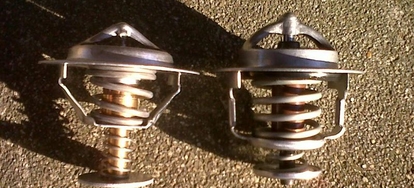

If there is still no fluid, but the temperature gauge rises, such issues may be caused by a valve. In case there is no leakage, start the car and wait for about 10-20 minutes until the car engine cooling system is warm enough to show the appropriate temperature. If the coolant fluid leaks around the thermostat housing, it requires replacement as a metal cover cannot be repaired, only changed. Noticing coolant leaks out means that the thermostat is stuck. Open the car’s bonnet and remove the radiator cap to see if there is any liquid allocated to the engine. In case there are no coolant leaks from the thermostat, then HVAC causes a problem.Ī faulty heater core might also cause the absence of warm air coming from a heater.īefore starting the car and allowing the engine to idle, check the radiator cap. Coolant leakageīefore blaming the stuck thermostat, have a look at the HVAC ( heater core and automatic conditioning) whether it is working properly.

There are possible troubles when the thermostat is stuck or the coolant leaks. It was mentioned above that when a car thermostat sticks, it may lead to severe problems with a faulty engine. What may happen when a thermostat is stuck? Once the thermostat is stuck open, the coolant remains unaffected as the engine warms up. When it is opened, cooler water is flowing in, causing evaporation of heat, which lowers engine temperature. A malfunctioning thermostat cannot control airflow properly.Ĭoolant cools the engine down as expected. Also, the motor needs constant temperatures and the thermostat is essential. In case the engine overheats, the car’s engine is impacted to serious damage.ĭuring cold temperatures, however, coolant flows less effectively. The valve opens, allowing fluids to pass through the circulating radiator. This thermostat is designed after an outlet in your bathtub. The thermostat on your vehicle only regulates the heating temperature.Ĭontrary to the domestic thermostat, where the temperature is not adjusted. There are many types of temperature gauge devices. What is the function of the engine thermostat?

When you start a vehicle that is working properly, the engine temperature increases, stabilizing the temperature gauge and ensuring fuel consumption, and preventing any environmental pollution. While operating, the engine thermostat is responsible for opening the thermostat valve allowing the coolant liquid to enter the cooler in case the operating temperature is higher than it should be, above the specified level. It is a kind of engine temperature gauge that indicates on your dashboard when the temperature rises or falls in a car engine. It may be located near the coolant fluid tank.Ī thermostat controls coolant flow and is responsible for closing it under the specified level in case the temperature is low. It is a small but essential component of the engine cooling system, you may find it where the upper radiator hose is attached to the engine block.

The thermostat housing is the place where a car thermostat is hidden.
#Bad coolant thermostat symptoms how to#
If you do not know how to unstick a thermostat in a car, we try to give you tips on how to succeed and how to detect the reason for a bad thermostat. A thermostat is a vital component of a car’s cooling system that adjusts coolant flow and coolant temperature, so its fault causes an extremely hot engine that leads to serious damage and the faulty thermostat should be removed.


 0 kommentar(er)
0 kommentar(er)
